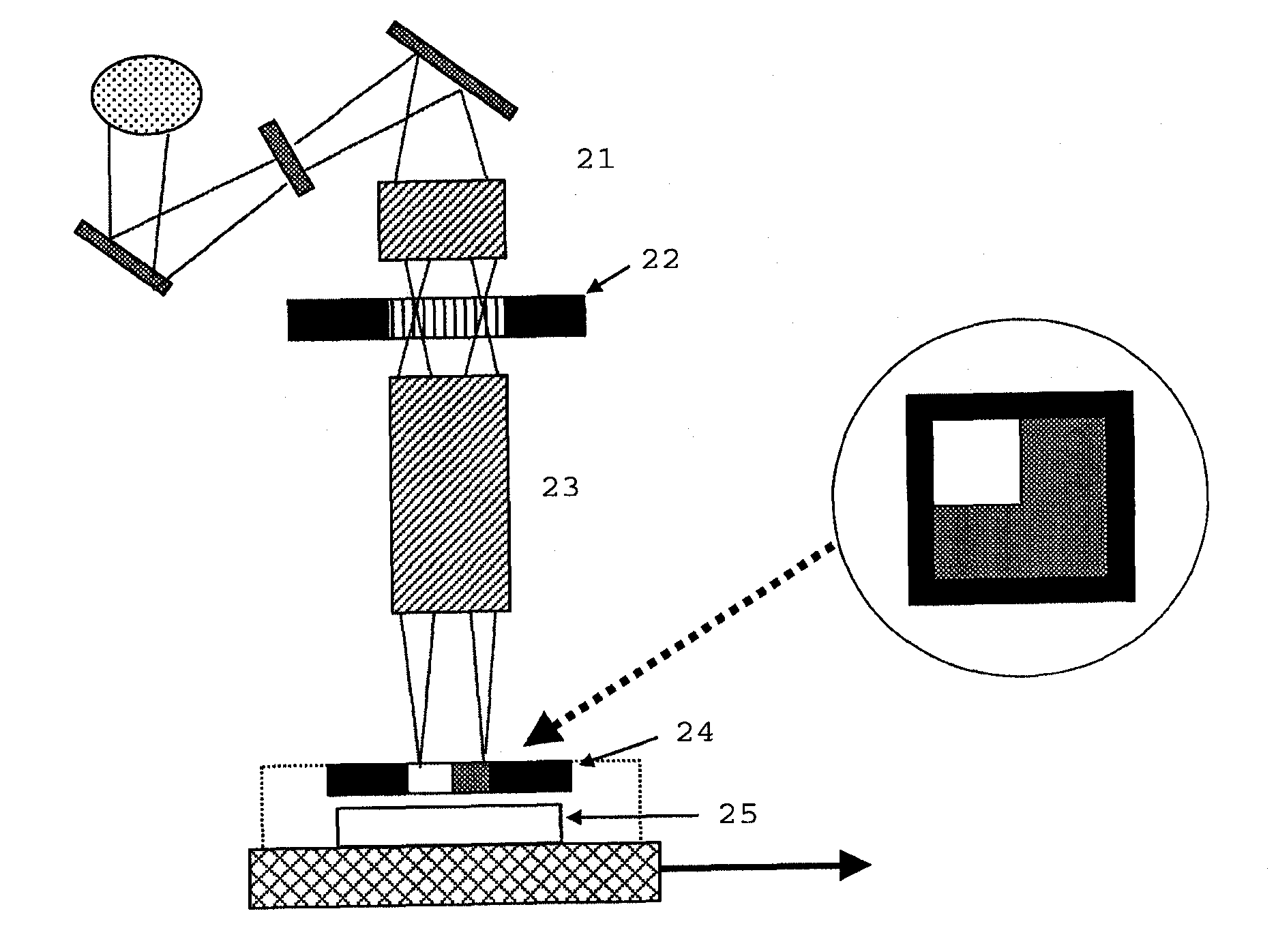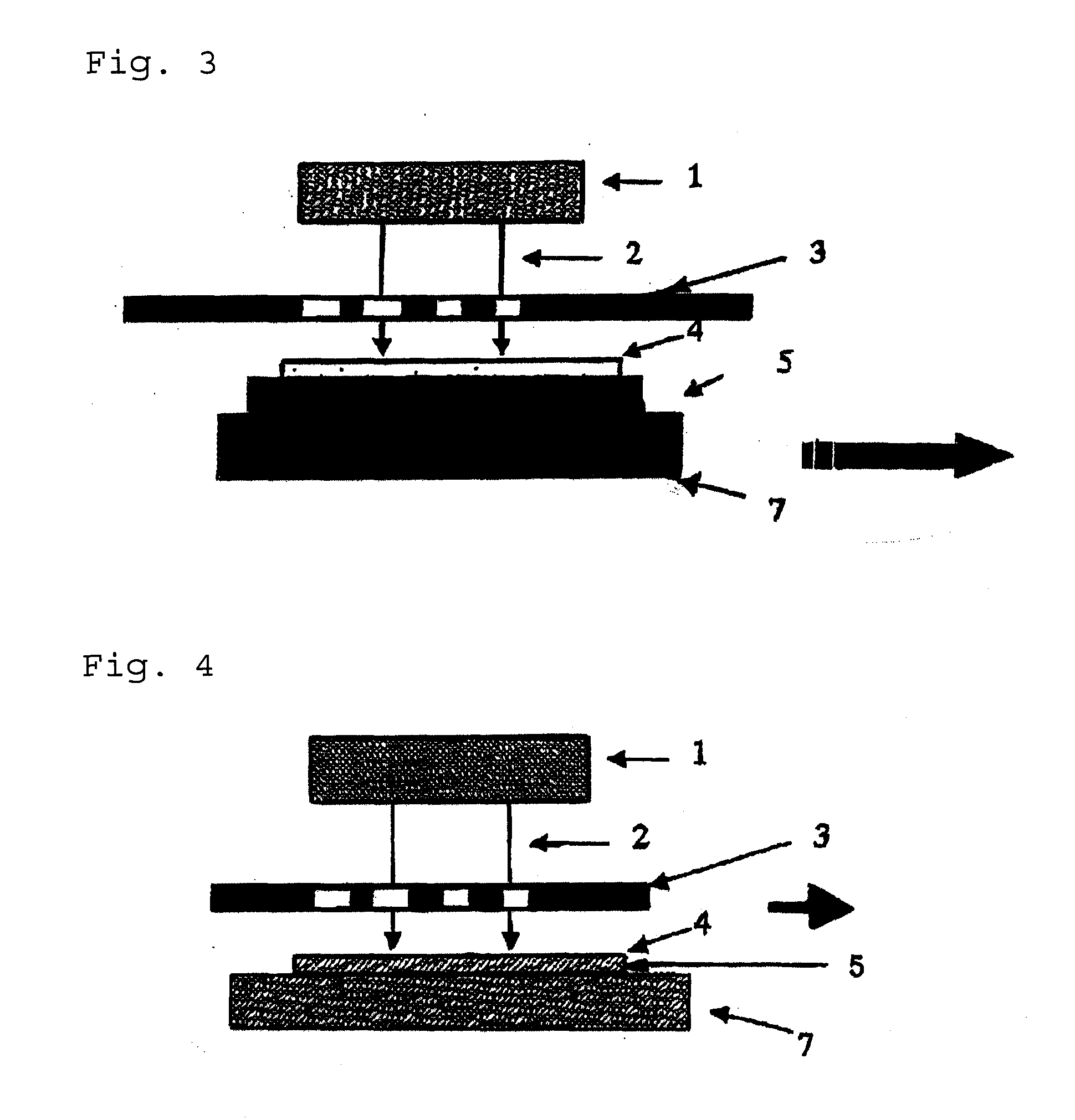Optical alignment method and liquid crystal display element
a liquid crystal display element and optical alignment technology, applied in non-linear optics, optics, instruments, etc., can solve the problems of reducing the contrast and productivity of the liquid crystal display element, deteriorating the display quality, and destroying the active element of the tft element,
- Summary
- Abstract
- Description
- Claims
- Application Information
AI Technical Summary
Benefits of technology
Problems solved by technology
Method used
Image
Examples
example 1
[0263]Optical alignment was carried out as shown in FIG. 3.
[0264]A polymer (may be called to “PMI-15” hereinafter) prepared by introducing a chalcone group as a side chain into a phenylmaleimide-styrene alternating copolymer through a methylene group was dissolved in γ-butyrolactone in an amount of 3%, and the obtained solution was applied to a quartz glass substrate 5 by spin coating and dried to form a polymer film having a thickness of 70 nm. Thereafter, the surface of the polymer film was exposed to polarized UV having a central wavelength of 350 nm from a polarization irradiating unit 1 through a slit exposure mask 3 while a movable stage 6 mounting the formed substrate was moved parallel to the X-axis direction (right direction) at a rate of several tens of micrometers per second so as to exposure the slit pattern. The irradiation energy was 2 J / cm2. A slit exposure mask pattern having line and space widths of 7 μm as shown in FIG. 7 was used in this example. Thereafter, two e...
synthesis example 1
Polymerization of Polyamic Acid
[0268]0.1 mol (22.4 g) of 2,3,5-tricarboxycyclopentylacetic dianhydride, 0.09 mol (9.73 g) of p-phenylenediamine and 0.01 mol (5.22 g) of cholestanyloxy(3,5-diaminobenzoyl) were dissolved in 350 g of N-methyl-2-pyrrolidone and reacted at 60° C. for 6 hours. Thereafter, the reaction mixture was added to an excessive amount of methanol to precipitate a reaction product. The precipitate was then washed with methanol and dried at 40° C. under reduced pressure for 15 hours to produce 34.2 g of polyamic acid (to be referred to as “polymer a” hereinafter).
Synthesis of Specific Polymer
[0269]300 g of N-methyl-2-pyrrolidone, 41.3 g of 1-bromo-8-(4-chalconyloxy)octane and 13.8 g of potassium carbonate were added to 14.9 g of the obtained polymer a to carry out a reaction at 120° C. for 4 hours. Thereafter, the reaction mixture solution was added to water to precipitate a reaction product. The obtained precipitate was washed with water and dried under reduced pres...
example 2
[0270]The polymer “b” obtained in Synthesis Example 1 was dissolved in γ-butyrolactone to prepare a 3 wt % solution, and the obtained solution was applied to a surface polished non-alkali glass substrate by spin coating and dried by heating at 180° C. for 5 minutes to form a polymer film having a thickness of 80 nm. The surface of the polymer film was exposed to polarized UV having a central wavelength of 350 nm through a slit exposure mask while a movable stage mounting the substrate was moved parallel to the surface of the polymer film at a rate of 100 μm / sec. The irradiation energy was 5 J / cm2, and the polarization direction of the polarized UV was the same as the moving direction. The slit width of the exposure mask was 7 μm. Thereafter, the exposed substrate was used to construct a non-parallel cell having a thickness of 18 μm, and the MLC6608 liquid crystals of Merk Co., Ltd. were filled to obtain a liquid crystal display element. The alignability of the liquid crystals was ex...
PUM
| Property | Measurement | Unit |
|---|---|---|
| speed | aaaaa | aaaaa |
| wavelength | aaaaa | aaaaa |
| pretilt angle | aaaaa | aaaaa |
Abstract
Description
Claims
Application Information
 Login to View More
Login to View More - R&D
- Intellectual Property
- Life Sciences
- Materials
- Tech Scout
- Unparalleled Data Quality
- Higher Quality Content
- 60% Fewer Hallucinations
Browse by: Latest US Patents, China's latest patents, Technical Efficacy Thesaurus, Application Domain, Technology Topic, Popular Technical Reports.
© 2025 PatSnap. All rights reserved.Legal|Privacy policy|Modern Slavery Act Transparency Statement|Sitemap|About US| Contact US: help@patsnap.com



